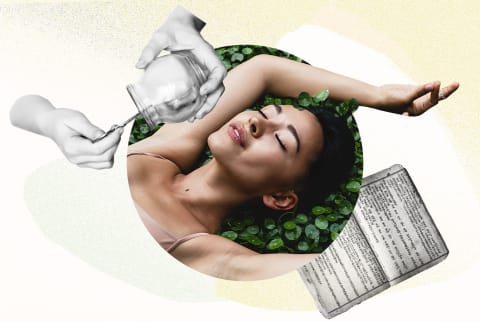As you may know, collagen keeps your skin looking firm and taut, and an increase in blood circulation pumps oxygen and nutrients to your skin cells, which is why many find their skin looking supple and glowy after facial cupping—take it from this personal review. Suctioning your skin with the small, soft cups can also help decrease puffiness and move lymph around, sculpting the face, neck, and jawline; by gliding the cups in upward strokes, you can help tone and lift the skin as well. But facial cupping isn’t exactly the same as what you may have seen dotting the backs of athletes. Both procedures promote blood flow and circulation, yes, but facial cups aren’t static. Meaning, they’re moved around quite a bit in order to promote blood circulation—they aren’t sitting on your face for an extended period of time. “Body cupping uses cups applied to specific areas for a longer period of time, which creates the bruising we are accustomed to,” notes celebrity facialist and founder of Cecilia Wong Skincare, Cecilia Wong. Facial cups are also typically made of soft silicone, while the ones meant for your body are usually larger in size and made of glass. So before you write off the procedure for fear of leaving the house covered in welts, know that facial cupping is way less intense. Additionally, says Yang, you’ll want to avoid facial cupping on open sores, acne pustules, and sunburned skin, as dragging the suctioning tool can exacerbate the wounds. “Facial cupping is not recommended during pregnancy or for persons with blood clotting conditions or persons on blood thinner medications,” she adds. As always, check in with a professional before attempting any new skin care procedures, at-home or otherwise. “I always recommend people consult a licensed acupuncturist for personalized advice,” Yang says. If you do opt for a professional cupping session (and you’re well-versed in all the potential risks and side effects above), she recommends arriving to your treatment well-hydrated with a clean, moisturized face. Your treatment will likely follow an acupuncture session: “After all of the needles are removed (from both the body and face), I apply a facial balm or facial oil to the skin,” says Yang. “I then begin cupping, which helps to reinforce all of the acupuncture points I just used on the face. I typically will cup the patient’s face for five to seven minutes until I can see some warmth and good circulation.” She also moves down to the neck: “We often follow the direction of the channels and always open up the neck and decollete with the facial cup,” she notes, suctioning horizontally rather than dragging up and down the neck. After, she follows with facial gua sha, jade rolling, and an acupressure facial massage. Post-treatment, she notes it’s important to stay hydrated: “I usually recommend my patients have some water with lemon and honey, or water with a pinch of sea salt,” she notes, for an extra hit of electrolytes to help regulate fluid balance2. Like many at-home beauty tools, they might not give you the same targeted results you’d see from a professional (looking at you, dermaplane), but you can try it out for yourself for a little jaw-sculpting routine. Here’s what many of those kits recommend:



